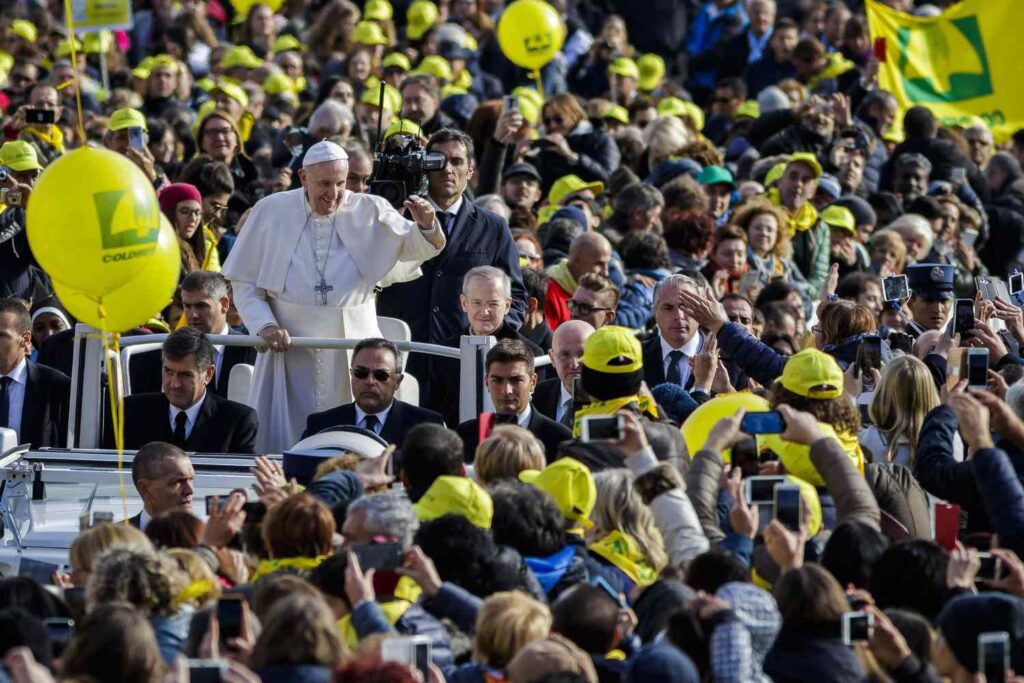Rome is readying itself for a Jubilee, one of Catholicism’s most infrequent celebrations.
Also referred to as a Holy Year, the Jubilee draws visitors from all over the world with the influx of believers — on top of other tourists — expected to hit 35 million in 2025, according to Italy’s National Tourist Research Institute (ISNART). When compared to the 13 million that visited in 2023, it’s clear Rome is in for some serious crowds next year.
Jubilees — where traditionally, Catholics come to ask for forgiveness — have been held at varying intervals since the year 1300. The interval settled at every 25 years in 1470, although Popes can declare Jubilees outside of that timeframe. Those who visit certain holy sites and participate in a rite of reconciliation are granted a plenary indulgence, which forgives all sins.
Getty Images
This time around the Jubilee officially begins on Christmas Eve of this year and ends on the holy day of the Epiphany, Jan. 6, 2026.
The celebration was declared by Pope Francis as the Year of Prayer, and will commence with the opening of the Holy Door at St. Peter’s Basilica, which all pilgrims aim to pass through at some point. This kicks off an entire year of Jubilee days for different groups, including artists, migrants, and prisoners. The Holy Doors of Rome’s three other papal basilicas — St. John in the Lateran, Saint Paul Outside the Walls, and Saint Mary Major — are also opened so that pilgrims can pass through.
Linda Martinez, a local who has experienced two Jubilees and is co-owner of Rome’s Beehive Hostel, advises anyone coming to the Eternal City at any point to book in advance, but recommends this even more strongly for those visiting next year.
“If you’re coming in 2025, you should plan ahead for accommodation, sights like the Colosseum and the Vatican Museums, for all the things you need reservations and tickets for,” she said.
Getty Images
Accommodation might be especially tricky. According to ISNART, the city’s 400,000 beds might not be able to meet the predicted demand at certain points. Martinez also noted that if past patterns hold true, it may be budget travelers who have the highest level of competition for accommodation in 2025.
“A lot of pilgrims stay outside the city,” she said. “They stay at campgrounds and in convents. The majority will be traveling on a budget.”
In addition to confronting large crowds, visitors to Rome in 2025 may have to pay a nightly tourist tax of up to €2 more than the current rates, which vary depending on the type of accommodation. Next year, they could range from €5 per person for places like campsites all the way up to €12 for luxury hotels.
Preparations for the Jubilee have been underway for months and include a number of infrastructure projects and the restoration and cleaning of many well-known works, such as Michelangelo’s Pietà and Gian Lorenzo Bernini’s altar canopy in St. Peter’s Basilica, as well as Bernini’s Fountain of the Four Rivers in Piazza Navona and his angels along Ponte Sant’Angelo. The Vatican Necropolis is also closed for tours. All are expected to be ready by the time the Jubilee kicks off.
Getty Images
Tiffany Parks, a Rome-based author, podcast co-host and trip consultant — specializing in itineraries covering the city’s lesser-known sights — has recently advised clients not coming for the Jubilee to reconsider visiting in 2025, but she has some tips for people who decide to come anyway.
“Don’t undervalue the idea of coming in winter, because Rome can be so beautiful in January and February,” she said.
Parks and Martinez agree that Easter 2025 will be extremely busy, and that it’s best to avoid coming then. They also both emphasize not feeling obligated to see certain major sights.
“Rome is a large city. There are many places that are incredibly interesting and significant to Roman history that don’t involve going to Saint Peter’s or the other sights that will be occupied by pilgrims during the Jubilee,” Martinez added.
Parks reinforces just how many masterpieces there are outside of the Eternal City’s well-known museums. “Rome is the only city in the world where you can see Raphael and Michelangelo in churches for free, and people don’t take advantage of it.”
Despite all the buzz, she also pointed out that Jubilees have been happening in Rome for centuries and that the city has long hosted millions of religious and other tourists.
“In the Holy Year of 1600, there were 3 million extra people in Rome, when there was only a population of about 117,000.” Regarding the Jubilee of 2025, she has no qualms.
“I think Rome can handle it,” she said.


